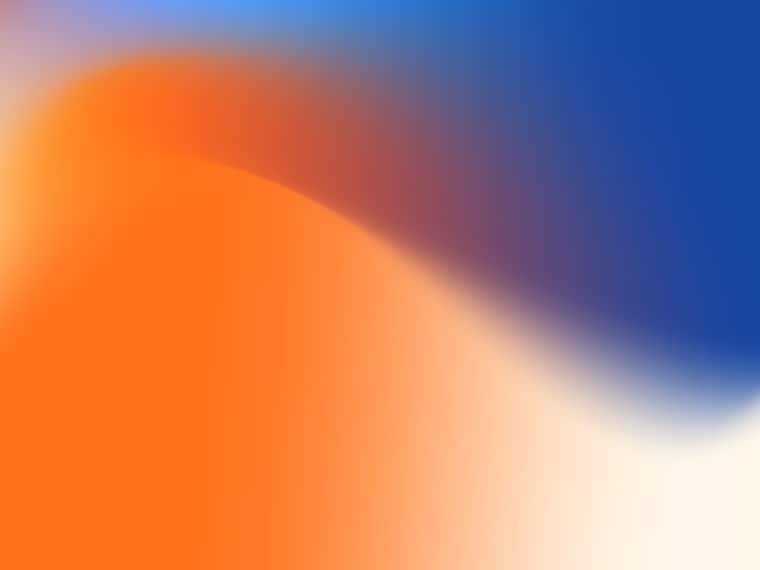Have you ever wondered what color orange and blue make when mixed? If you mix orange and blue, you’re combining a primary color with its complementary color. Let’s see what this mixture produces.
Orange and blue are opposite on the color wheel, meaning they are complementary colors. Thus, they form a color harmony that provides the most remarkable contrast.
As you may recall from art classes, the most likely outcome is an earthy color when you blend two complementary hues.
So what color do orange and blue make when mixed together?
What Color Do Orange and Blue Make in Painting?
When you mix orange and blue paint, you’ll get brown. That’s because blue is a primary color, while orange is a secondary color made of yellow and red. So, mixing blue and orange is equivalent to combining all primary colors, which results in brown.
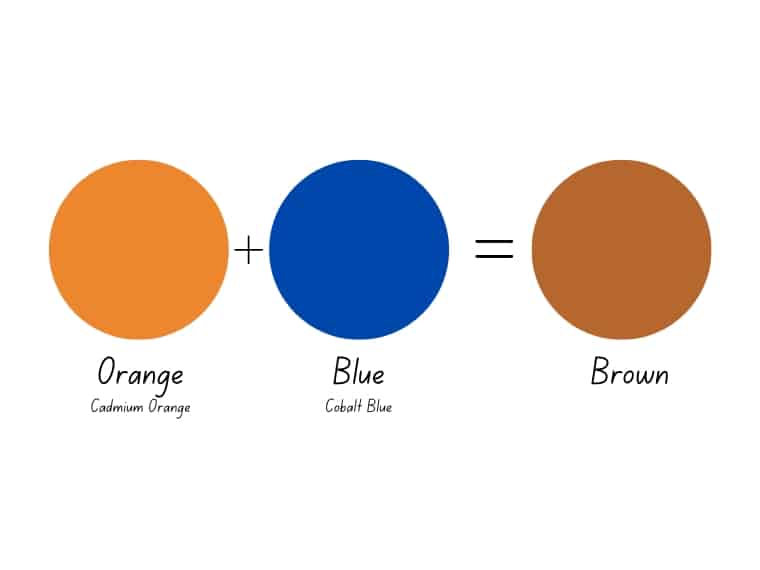
Moreover, mixing the primary color blue with its complementary color – orange, neutralizes the brown. Thus it creates a less vibrant or more muted color. It can be brown, caramel, or even a muted orange.
Understanding the RYB Model
The RYB color wheel is actually a graphic representation of the RYB color model, a traditional model used in art.
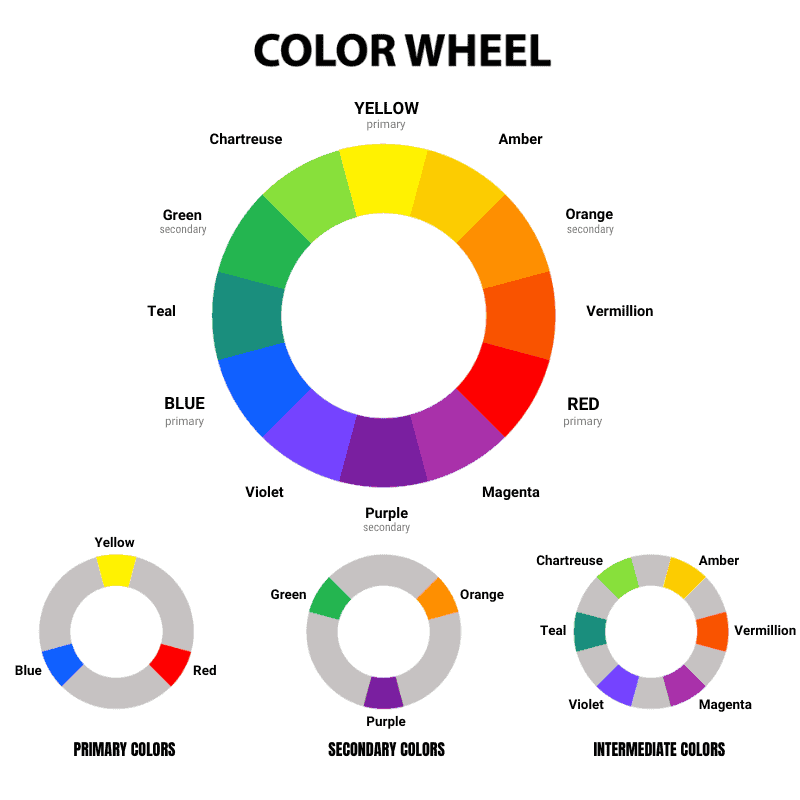
The primary colors of the RYB model are red, yellow, and blue. Mixing them with black and white allows you to create variations of any color. Therefore, they cannot be created in this color space by mixing other colors.
Secondary colors are those created by mixing two primary colors. For example, in the RYB model, the secondary colors are purple, orange, and green.
Intermediate colors are produced by mixing a primary color with an adjacent secondary color. There are six intermediate colors in the RYB model: amber, vermillion, magenta, purple, teal, and chartreuse.
Tertiary colors, on the other hand, are created by mixing two secondary colors. Examples of tertiary colors in the RYB model include brown, olive, and slate.
Another definition of tertiary colors says that they can be created by combining primary and secondary colors.
However, this definition does not apply to traditional art but to RGB and CMYK color models. Hence the confusion between tertiary and intermediate colors.
Other Ways to Make Brown Paint
A simple way to make brown is to mix the primary colors, red, yellow, and blue, in equal proportions.
Another method is to mix the primary colors with their complementary colors. For example, you can mix orange and blue, purple and yellow, or green and red.
Any of these mixes will give you different shades of brown, depending on the base colors’ undertones.
If you want to go for tan, mix the primary colors but add more yellow. Make your base by blending red, yellow, and blue, then add a little yellow paint.
When it comes to beige, this is a tint of brown. Basically, it’s a very light version of brown. If you want to create beige, make your base from orange and blue or the primary colors, and then add white until you reach the desired shade.
If you want to make espresso instead, add a little black or purple to your base of orange and blue mix.
When mixing the primary colors, add more red and blue if you want to make espresso.
Also, you can add more yellow and red to the mix to get a reddish-brown, like chestnut. Can you see it? It’s easier to mix the primary colors to make your brown base.
Learn more about what colors make brown.
Why Brown Doesn’t Appear on the Color Wheel
Brown does not appear on the color wheel because it is a composite and neutral color. You can, however, make it by combining complementary colors and even the primary colors – red, yellow, and blue.
Mixing Tints and Shades of Brown
Whether you mix orange and blue or all three primary colors, it’s essential to know how to create brown tones and shades.
You can adjust the color temperature from the amount of blue or orange paint used in the mix. For example, more blue will result in a cooler brown, while more orange will create a warmer brown.

Lighter Brown
To create lighter variations or tones, add white paint to the mix. The darker your base hue, the more white you need to add to make a difference.
Darker Brown
Darker variations are called shades. These are created by adding black to your base hue. Be careful, as black is a strong color and can easily overpower your hue.
To create shades, you can also use other dark colors. For example, if you mix blue and orange, you can use more blue in the mix. This will give you a darker version of the base color resulting from the preliminary mixture.
Brown Meaning
The color brown has something from each primary color. It combines the relaxation of blue, the warmth of yellow, and the grounding qualities of red. Thus, it is a color associated with comfort, stability, and safety.
Furthermore, it symbolizes earthiness, reliability, honesty, and appreciation.
On the other hand, brown can be perceived as boring, dull, and shy.
Orange and Blue Make Brown or Muted Orange
Mixing orange and blue together is actually mixing a primary color with its complementary color. Therefore, this mix can also be called a primary complementary mix.
Although it often results in a muddy brown, this mixture can also produce a muted orange. Why muted? Because mixing orange (and not only) with its complementary color neutralizes it, resulting in a muted orange.
So, if you’re wondering what colors make orange muted, the simple answer is a mix of orange and blue.
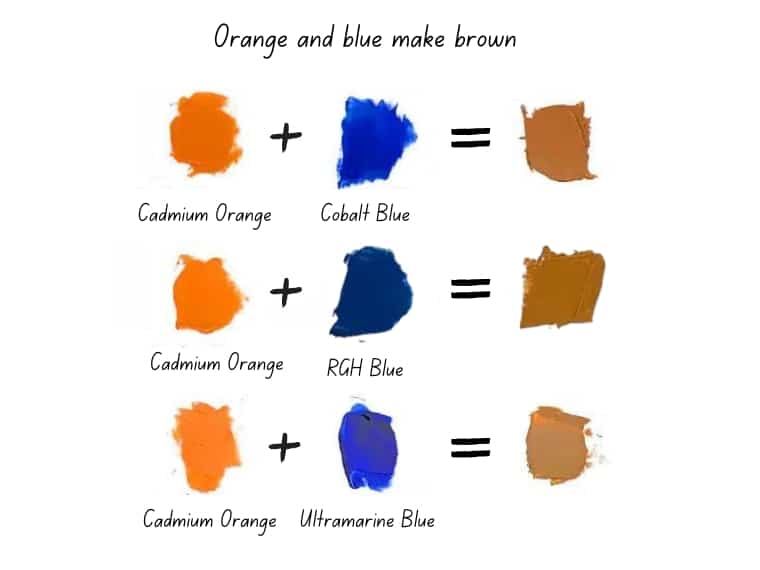
The difference between brown and muted orange lies in how much blue you mix with orange. Or the orange and blue paint you use.
For example, Cadmium orange and Ultramarine blue make a cooler, muted orange.
The same orange mixed with RGH blue makes a greenish, muted orange that leans more towards brown.
Mixing Cadmium orange with Cobalt blue gives you a warmer, muted orange.
Why Does Mixing Blue and Orange Produce Different Colors?
Orange and blue make different variations of browns or even muted orange because any color carries a bias, which means it leans towards a warmer or cooler color.
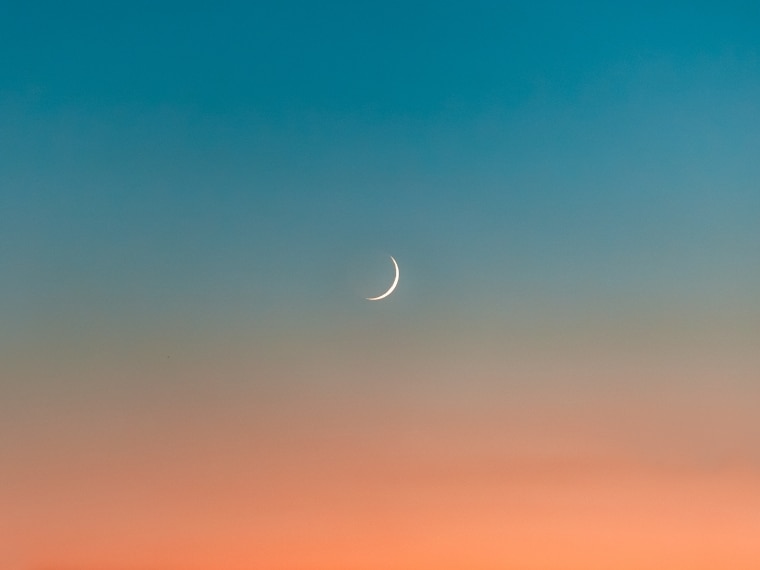
For example, in this mix, you can use a warm reddish blue or a cool greenish blue.
Moreover, they are complementary colors. When complementary colors are mixed together, they tend to neutralize each other. Thus, it results a less vibrant brown, or muted orange.
Some mixtures make different colors depending on the medium you mix in. Other mixtures produce the same color in all spaces. An example is purple and red.
However, the type of mixing in RYB or CMYK is different from RGB. Thus, sometimes you may encounter surprises.
What Colors Can You Mix to Create Blue and Orange?
Blue is a primary color in the RYB space, meaning that it cannot be created by mixing other colors.
Suppose you use the primary colors of the CYMK color space – a subtractive color model. In that case, blue can be created by mixing cyan and magenta.
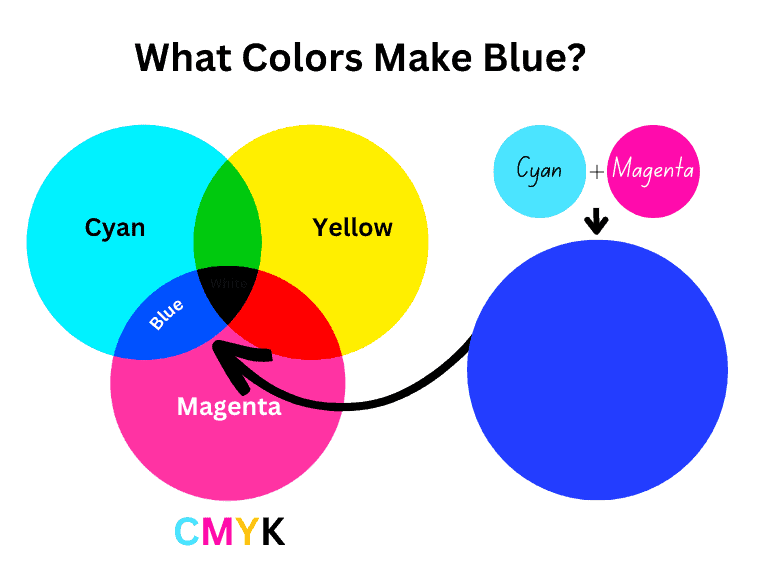
Orange is a secondary color on the traditional color wheel, created by mixing red and yellow. However, adding blue (the third primary color) neutralizes the orange and becomes dull, muted, or muddy. Also, the more you add, the more it tends towards brown.
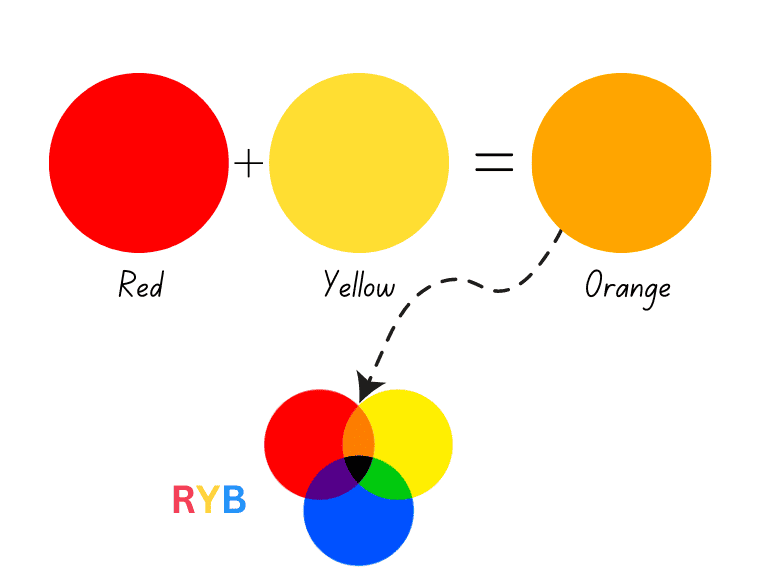
If you want to create red-orange, mix one-part red with two parts yellow.
On the other hand, to create a red-orange, use one-part yellow and two parts red.
What Color Do Orange and Blue Make in Lighting?
Orange and blue light make white. This is because orange is a secondary color made by overlapping red and green light, whereas blue is a primary color.
As a result, this mixture includes all three primary colors of light, resulting in white.
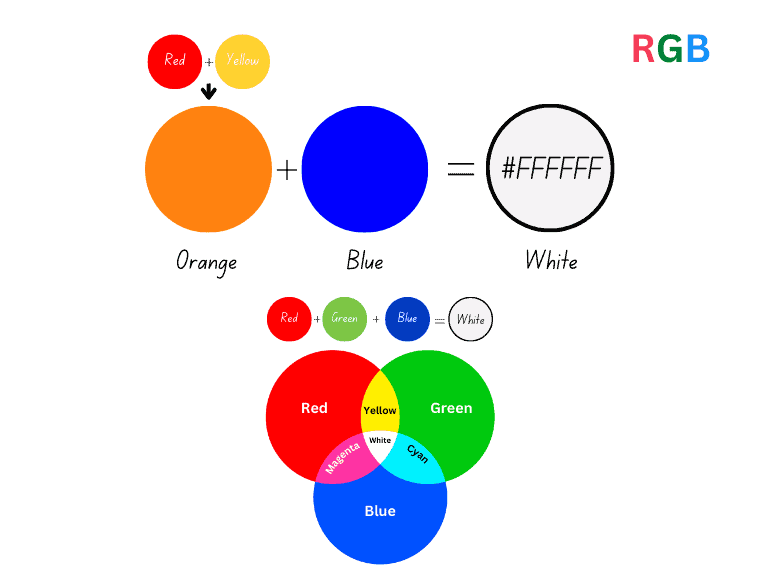
When mixing light, the tertiary colors are made by combining a primary and a secondary color in equal quantities. This is different from RYB and traditional art, where they are created by mixing two secondary colors
Understanding the RGB Model
The RGB color model is used in mixing colors in lights. RGB is an additive color model, unlike the subtractive CMY model.
The primary colors of the RGB model are red, green, and blue. By mixing the primary colors, you get the secondary colors – cyan, magenta, and yellow – the primary subtractive colors.
When you combine all three primary colors of the RGB model, you get white light.
What Color Do Orange and Blue Make in Printing?
Blue is a secondary color on the CMYK color wheel, made by mixing cyan and magenta. On the other side, orange is made up of yellow and magenta.
Thus, when you mix blue and orange in CMYK, you mix all the primary colors of CMYK space, resulting in black.
So the mix uses the primary colors of CMYK, which make black.
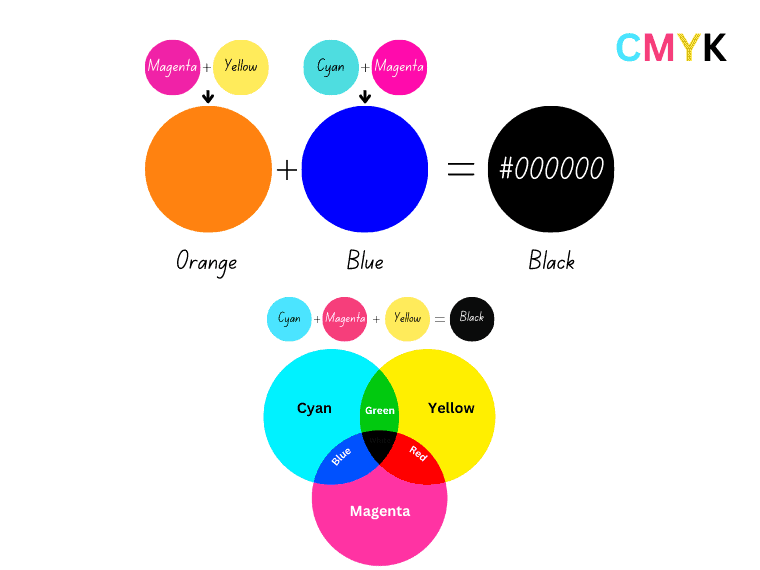
Understanding the CMYK Model
When it comes to the printing industry, there is a subtractive model called CMYK. The primary colors of the CMYK color space are cyan, magenta, and yellow. This model also uses black to streamline printing and add blackness.
CMYK is a more modern color model that can achieve a larger range of colors than the RYB space.
It is also called a subtractive model because of the way pigments subtract, abort and reflect certain wavelengths when mixed.
By mixing the primary colors (cyan, magenta, and yellow), you get the additive colors (red, green, and blue), which are the primaries of the RGB model.
This type of color mixing starts with white and gets darker as color is added. For example, you get (almost) black when you mix cyan, magenta, and yellow.
Why Does Mixing All Colors Make Black?
When the primary colors of the CMY model are mixed together in equal quantities, they block all other colors and create black.
This happens because of how pigments work. Pigments have color because they absorb certain colors of light and reflect others.
When you see a blue pigment, for example, it absorbs all colors of light except blue, which is reflected back to your eyes.
When you mix pigments together, each pigment continues absorbing some colors of light.
As more pigments are added to the mix, the resulting color absorbs more and more of the light spectrum until no colors are reflected to your eyes, creating the perception of black.
Cyan, magenta, and yellow create black when mixed together because they are subtractive primary colors. Subtractive color mixing works by subtracting (or absorbing) some wavelengths of light from the spectrum.
In the case of the CMY color model, cyan absorbs red light, magenta absorbs green light, and yellow absorbs blue light. When you mix all three together, they absorb all colors of light, resulting in black.
The black produced by blending these colors is not a true or pure black but rather a dark and muddy hue.
Do Orange and Blue Go Together in Design?
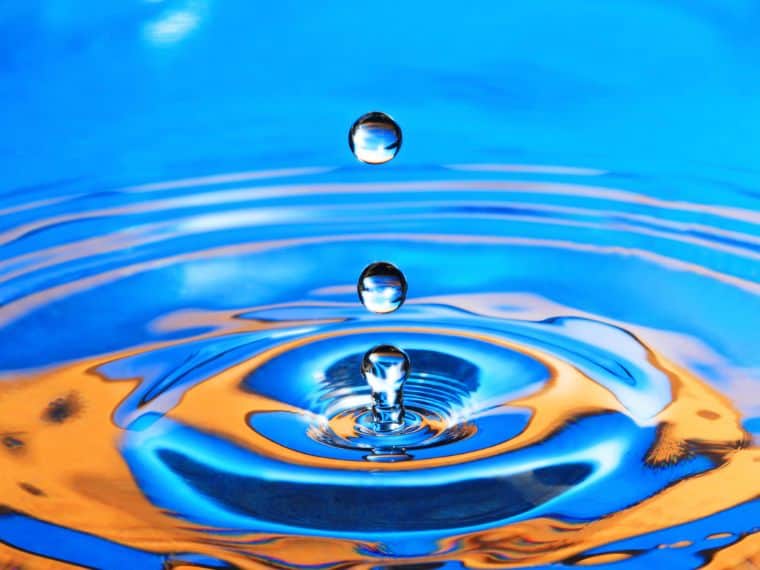
Orange and blue are complementary colors, which means they are opposite on the color wheel. Complementary colors provide the most remarkable contrast of all color schemes. So orange and blue go well together.
However, when you see orange and blue mixed, they appear as a muddy brown or a muted orange. So basically, this mix is not as impressive as matching the two colors together.
Did you enjoy this article about the color produced when blue and orange are mixed? Share it with a friend who is interested in this mixture.

